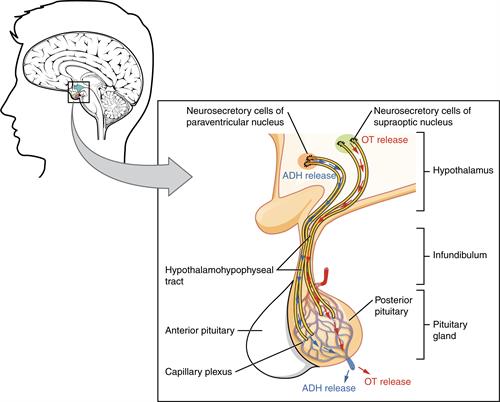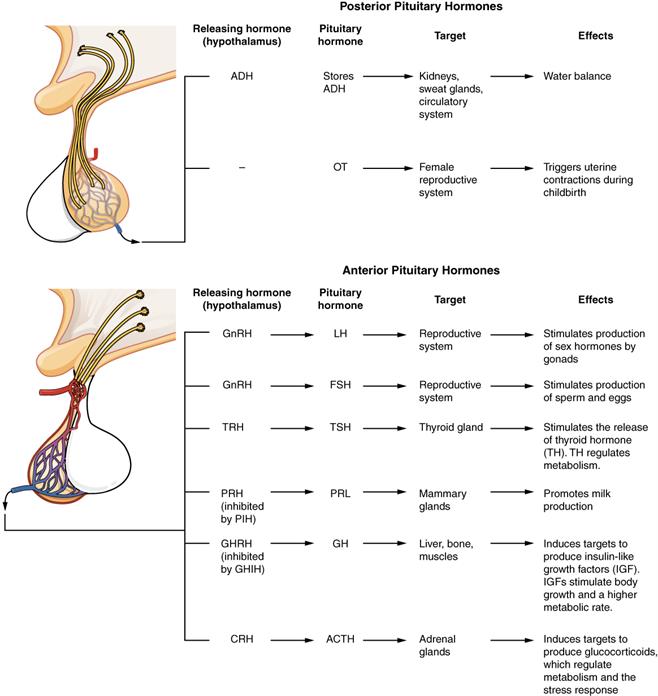
PUMPA - SMART LEARNING
எங்கள் ஆசிரியர்களுடன் 1-ஆன்-1 ஆலோசனை நேரத்தைப் பெறுங்கள். டாப்பர் ஆவதற்கு நாங்கள் பயிற்சி அளிப்போம்
Book Free DemoIn the previous theory, we studied growth hormone and its function. Let us now take a look at other hormones that are secreted by the anterior pituitary.
2. Thyroid-stimulating hormone (TSH) or Thyrotropin:
The hormone controls the growth and activity of the thyroid gland. TSH regulates the synthesis and secretion of the hormones thyroxine and tri-iodothyronine. It also influences the uptake of iodine.
3. Adrenocorticotropic hormone (ACTH):
The hormone stimulates the adrenal cortex of the adrenal gland to produce its hormones. It also influences the protein synthesis in the adrenal cortex.
4. Gonadotrophic hormones (GTH):
GTH can be categorized as:
a. Follicle-stimulating hormone (FSH) and
b. Luteinizing hormone (LH).
LH and FSH are vital for the development of gonads.
a. Follicle-stimulating hormone (FSH):
In a male, FSH stimulates the germinal epithelium of testes to form sperms (spermatogenesis). In females, FSH stimulates the growth of ovarian follicles, their development in the ovary and the secretion of oestrogen.
b. Luteinizing hormone (LH):
In a male, LH activates the Leydig cells of the testes to secrete androgens or testosterone (male sex hormone). In females, LH causes ovulation, i.e., rupture of mature Graafian follicle. It also stimulates the development of corpus luteum, and the release of estrogen and progesterone from corpus luteum (female sex hormones).
5. Prolactin (PRL):
Prolactin is also called lactogenic hormone. The hormone initiates the development of mammary glands during pregnancy and stimulates the production of milk after childbirth. That is why it is known as the "hormone of maternity".
Hormones secreted by Neurohypophysis:
The secretion of the posterior lobe is called pituitrin. The posterior pituitary gland does not produce hormones but stores and secretes the hormones produced by the hypothalamus. The two hormones secreted are vasopressin and oxytocin.

Posterior pituitary gland and release of oxytocin and ADH
a. Vasopressin or Antidiuretic hormone (ADH):
ADH has two main functions:
1. It increases the reabsorption of water in the kidneydistal convoluted tubule and collecting ducts of nephrons present in the kidneys. The name antidiuretic hormone is because it reduces the loss of water through urine.
2. The involuntary muscles present in the walls of the gall bladder, urinary bladder, intestine and blood vessels are stimulated to contract by ADH.
The deficiency of ADH reduces the reabsorption of water, which causes an increased urine output. The condition is called polyuria, and the deficiency disorder is called Diabetes insipidus.
b. Oxytocin:
Oxytocin promotes the contraction of smooth muscles of the uterus at the time of childbirth. It also helps in the milk ejection from the mammary gland after childbirth. Oxytocin is thus called "Birth hormone" and "Milk ejecting hormone".
The cells present in the intermediate zone between the anterior and posterior lobes secrete melanocyte-stimulating hormone (MSH). Production of MSH in the skin is responsible for melanin production when UV light is exposed.
A summary of major pituitary hormones and their function is given below:

Hormones released by the pituitary gland and their functions
Reference:
https://commons.wikimedia.org/wiki/File:1807_The_Posterior_Pituitary_Complex.jpg
https://upload.wikimedia.org/wikipedia/commons/4/4a/1810_Major_Pituitary_Hormones.jpg